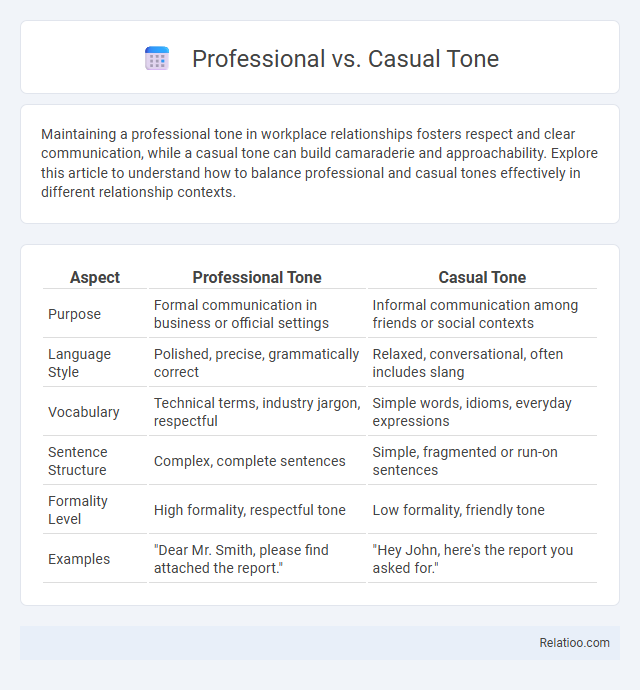Maintaining a professional tone in workplace relationships fosters respect and clear communication, while a casual tone can build camaraderie and approachability. Explore this article to understand how to balance professional and casual tones effectively in different relationship contexts.
Table of Comparison
| Aspect | Professional Tone | Casual Tone |
|---|---|---|
| Purpose | Formal communication in business or official settings | Informal communication among friends or social contexts |
| Language Style | Polished, precise, grammatically correct | Relaxed, conversational, often includes slang |
| Vocabulary | Technical terms, industry jargon, respectful | Simple words, idioms, everyday expressions |
| Sentence Structure | Complex, complete sentences | Simple, fragmented or run-on sentences |
| Formality Level | High formality, respectful tone | Low formality, friendly tone |
| Examples | "Dear Mr. Smith, please find attached the report." | "Hey John, here's the report you asked for." |
Understanding Professional and Casual Tone
Professional tone employs formal language, clear structure, and polite phrasing to convey expertise and respect, often used in business or academic communication. Casual tone includes informal language, conversational style, and relaxed phrasing, suited for friendly interactions and social media. Understanding the context and audience is key to selecting the appropriate tone, ensuring effective communication and desired impression.
Key Differences Between Professional and Casual Tone
Professional tone emphasizes clarity, formality, and respect, maintaining a structured and objective style suitable for workplace communication. Casual tone is more relaxed, conversational, and personal, often incorporating slang, contractions, and emotional expressions to create a friendly atmosphere. Your choice between these tones impacts how your message is received, influencing professionalism and relatability.
When to Use a Professional Tone
A professional tone is essential when addressing clients, colleagues, or formal business communications to ensure clarity, respect, and credibility. Your language should be precise, polite, and free of slang or overly casual expressions to maintain a sense of professionalism. Using a professional tone helps build trust and conveys expertise, especially in emails, reports, and presentations within a corporate or academic environment.
Situations Best Suited for a Casual Tone
Casual tone is best suited for informal communication such as internal team emails, social media interactions, and customer service conversations where approachability and relatability enhance engagement. This tone helps build rapport with audiences by using conversational language and a friendly, relaxed style that encourages open dialogue. It is ideal for situations where fostering a personal connection outweighs the need for strict professionalism or formality.
Impact of Tone on Audience Perception
Professional tone conveys authority and trustworthiness, influencing your audience to perceive your message as credible and reliable. Casual tone fosters approachability and relatability, making your communication feel more personal and engaging. The choice of tone significantly shapes how your audience interprets intent, sincerity, and expertise, ultimately affecting their response and engagement.
Benefits of a Professional Communication Style
A professional communication style enhances clarity and fosters trust in business environments, leading to stronger relationships and increased credibility. It minimizes misunderstandings by using precise language, which improves overall efficiency and productivity in the workplace. Consistently maintaining a professional tone supports brand reputation and reflects a commitment to respect and professionalism in all interactions.
Advantages of Using a Casual Approach
Using a casual tone creates a more relatable and engaging atmosphere, making it easier for Your audience to connect emotionally and build trust. It encourages open communication and fosters a friendly environment, often leading to increased responsiveness and loyalty. Casual language simplifies complex ideas, making information more accessible and enjoyable for diverse audiences.
How to Choose the Right Tone for Your Message
Choosing the right tone for your message depends on the audience, purpose, and context of communication. A professional tone is essential in formal settings, emphasizing clarity, respect, and credibility, while a casual tone suits informal interactions by promoting approachability and relatability. Consider your message's goal and your audience's expectations to effectively engage and convey your intent.
Common Mistakes in Tone Selection
Choosing between professional and casual tone often leads to common mistakes such as using overly formal language in informal settings or excessive slang in professional communication. Your message risks misinterpretation or diminished credibility when tone selection does not align with the audience's expectations or the context of the conversation. Proper tone calibration enhances clarity, builds rapport, and ensures your communication objectives are effectively met.
Tips for Balancing Professionalism and Friendliness
Maintaining a balanced tone between professional and casual enhances communication effectiveness in diverse settings. You can achieve this balance by using clear, respectful language while incorporating approachable phrases that foster connection. Prioritize clarity, empathy, and audience awareness to ensure your message feels both credible and relatable.

Infographic: Professional vs Casual Tone
 relatioo.com
relatioo.com